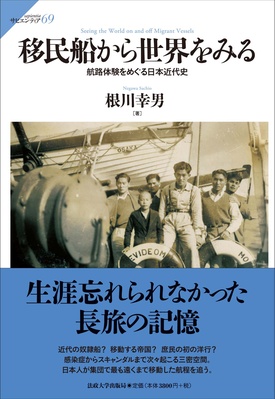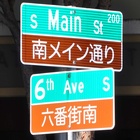Read "Seeing the World from Immigrant Ships: A Modern History of Japan's Sea Route Experiences."
In Japan, an island nation, it is now common for people to travel abroad by airplane, apart from luxury liner cruises. However, at least until shortly after the war, the only way to travel was by ship. In other words, ships transported people, goods, and information as Japan opened up and modernized. Looking at the world at large, travel between continents was by ship, and with the advancement of shipbuilding technology, ships changed from sailing ships to steamships and then diesel-engine ships, allowing more people and goods to be transported faster.
Amid the active flow of people and goods traveling around the world using these ships, it was of course also ships that were used to transport large numbers of Japanese people as "immigrants," and these were primarily emigrant ships used for this purpose.
The Significance of the "Sea Route Experience"
Traveling on immigrant ships is a unique experience. Despite this, it does not seem to have been covered in detail in immigration studies. A recently published book, "Seeing the World from Immigrant Ships: A Modern History of Japan Through Voyage Experiences" (Hosei University Press), focuses on this issue.
Author Yukio Negawa specializes in the history of immigrants and is currently a special researcher at the International Research Center for Japanese Studies. As previously introduced in this series, his book, " São Paulo Oriental Town: A Town Made by Immigrants - Modern Japan on the Other Side of the Earth ," he continues to actively research immigration, including Japanese immigration to Brazil.
Focusing on emigrant ships, the author points out that a challenge in studying migration (history) is that "much of the research to date seems to limit its focus to land, and there has been little interest in the act and process of crossing the sea and its meaning, that is, the 'seafaring experience', as a premise for the 'transnational' movement of the people of the Japanese archipelago."
Very little has been written for the general public about immigrants and the ships they used (immigrant ships), with only one book published in 1998, "The History of Japanese Immigration as Seen Through Ships: From Kasato Maru to Cruise Liners" (Yamada Yoshio, Chuokoron Shinsho). Yamada is not an immigration researcher, but specializes in maritime history. At the time when passenger liners were the main form of international transportation, a considerable number of them were immigrant ships carrying immigrants. As such, he came up with the idea that "in order to get closer to the reality of passenger ships in maritime history, we need to delve into the history of immigrant ships and understand the ships and their routes in relation to society," and so he began working on the history of immigrant ships.
However, as Yamada researched, he noticed that there were very few entries about immigrant ships in immigration history books. He found the answer to this in the description of Tatsuzo Ishikawa's novel "Soubou," which is about immigrants to Brazil. Soubou first describes the journey to Brazil as immigrants, but later added a second part set on the immigrant ship and a third part about labor in Brazil.
Is the immigrant ship blank?
The passage that struck Yamada as interesting was the following in Part 2:
"For all the immigrants on this ship, the 45 days at sea were almost a blank page in their lives. Their goal was the farmland of Brazil, and the life on board was meaningless until they got there. It was a boring period in which all they had to do was to be strong and get there."
Indeed, if this is the case, even if it took a long time, it is not something worth recording, and one might not even feel like doing so. This is especially true if one is migrating alone to earn money. It is true that, given that there have been many people who have been on migrant ships, there are not many records of what happened on board. However, "Seeing the World from Migrant Ships" teaches us that this is not the case when it comes to "life on board a ship being meaningless."
The author provides an overview of the history of immigrant ships, which carried approximately 240,000 Japanese immigrants on a total of 640 ships over the 65 years from 1908 to 1973, including the war, and delves into how people lived, thought, and acted within the limited time and space of the immigrant ships, based on the specific experiences of those who were on board.
The book focuses mainly on immigrant ships bound for South America, whose routes leave Japan, pass through Singapore, cross the Indian Ocean, travel south along the east coast of the African continent, and round the Cape of Good Hope. They then cross the Atlantic Ocean and enter the port of Santos in Brazil. The journey can take up to two months. It is the first time that the immigrants have travelled overseas, and they are setting out on a long voyage into a completely unknown world, but life on board, which is reminiscent of an adventure, is not something that they can simply endure.
The logbook tells us
This book brings to light the experiences of the voyage through official emigrant transport journals and the diaries and records of people who were actually on board. One of these is the record of the voyage to Brazil by journalist and social activist Gennosuke Yokoyama, who boarded an emigrant ship to South America at the end of the Meiji era.
Immigration to Brazil began in 1908 as a national policy with the voyage of the Kasato Maru. Yokoyama accompanied the third voyage (1912) of the Itsukushima Maru. Yokoyama reports on what happened on board the ship and how people behaved. For example, when the ship passed the equator during the voyage, an equator festival was held, and the immigrants paraded around the deck in Western clothing and shoes, and entertainment such as plays were also performed.
On the other hand, he also criticized the poor morals and sexual scandals on board the ships. In response to these problems, the immigration companies that managed the immigrant ships asked people to be mindful of their lifestyle on board, from the perspective of how they would be seen as citizens of a "first-class country in the world" once they had immigrated. Yokoyama himself worked to raise awareness by publishing a newspaper on board the ships and holding Portuguese language classes.
Fifteen years later, in 1927, the diary of Tanabe Sada, who served as assistant supervisor of the immigrant transport ship Kanagawa Maru bound for Brazil for Nippon Yusen, clearly shows that the ship was a small self-governing organization and community. A group leader was elected for each area on the ship, and with the immigrant transport supervisor as the head, roles were decided and a family head meeting was held. An onboard library was also set up, and a grand sports day was held as the voyage drew to a close.
On the other hand, the book also records troubles on board the ship. Not only were there illnesses, injuries, and accidents, but there was also one suicide on the voyage. There were also cases of fraud on board.
The other voyage diary is a very valuable one written by the immigrants themselves, compiled by 786 people who traveled to Brazil on the Osaka merchant ship Manila Maru in 1928. It is in the form of a booklet, 74 pages in total. The cover reads "114th Brazil Voyage Diary," "Compiled by the Youth Association, February 11, 1929." It is mimeographed on what appears to be straw paper, and was apparently obtained when the immigrants called at Durban, South Africa.
In addition to the diary, there are also records about the ship's self-governing organization and schools, such as kindergartens and elementary schools. The reason for compiling this diary is clear: "Not only to commemorate the people who had been with us on the voyage of over 10,000 miles taking their first steps overseas, but also to report this great achievement to friends and acquaintances back home" (author).
As the voyage drew to an end, the young people members devoted themselves to the editing work, and it seemed that there were more people than expected who were eagerly awaiting the diary.
During the long voyage, hygiene problems led to epidemics of infectious diseases, and some voyages resulted in many deaths from measles and other diseases. Incidents and accidents also occurred. However, many people were able to live out their lives as immigrants thanks to the wisdom and efforts of those who tried to make the voyage safe and orderly despite such hardships and achieve their goal. In that sense, the immigrant ship was a dense time and space that served as a bridge to a foreign land.
© 2023 Ryusuke Kawai







